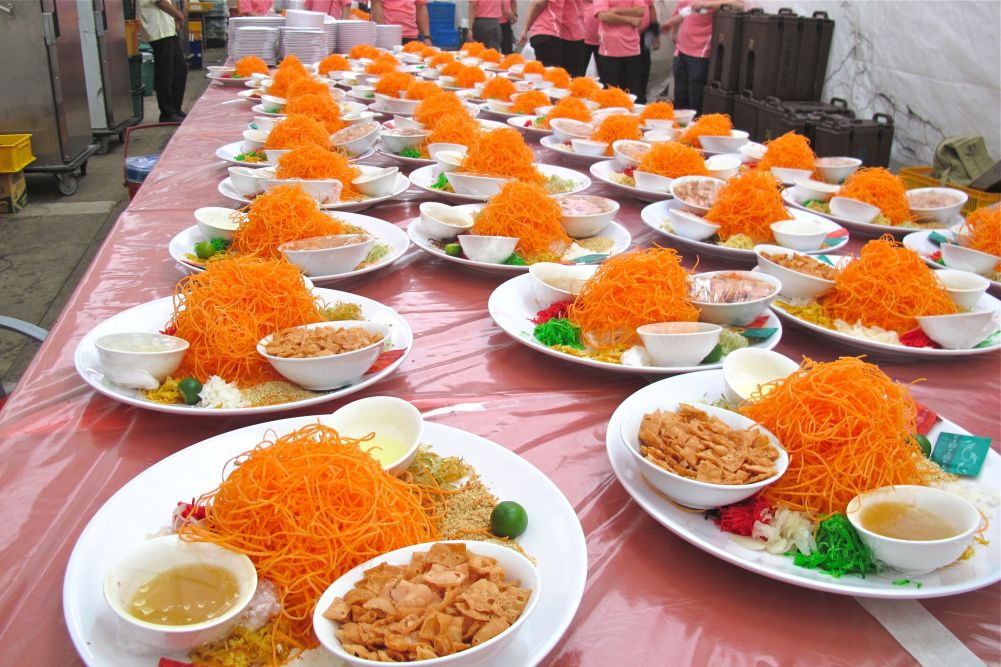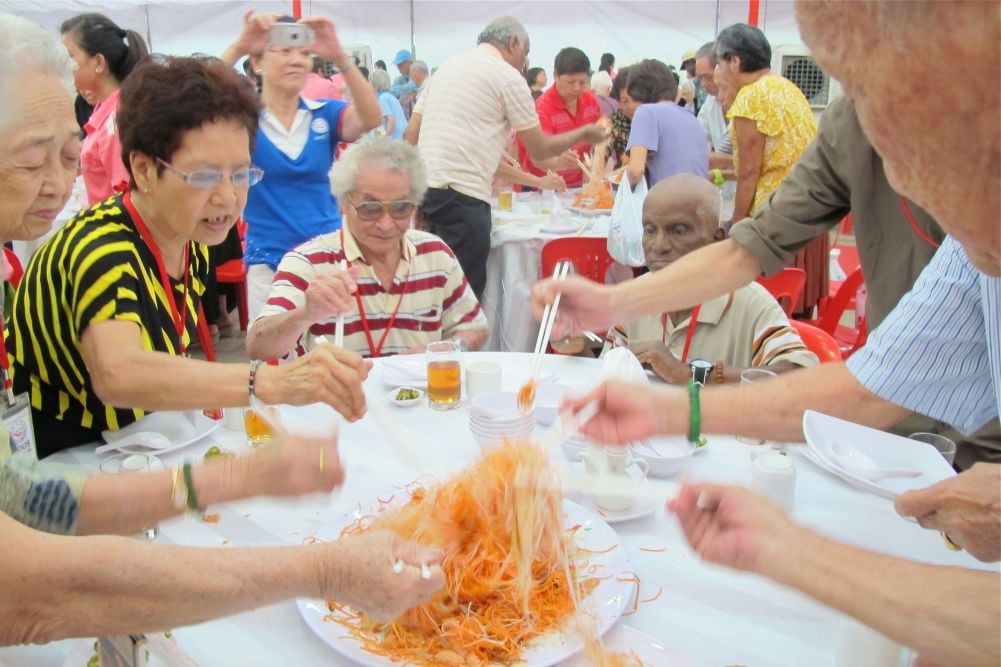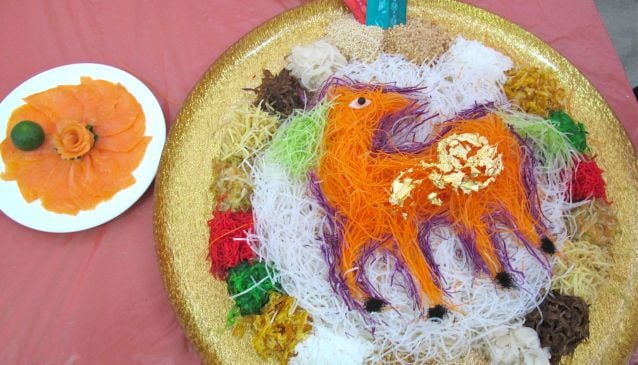My Destination Singapore Kitchen- Yu Sheng
The higher you toss, the greater will be your fortune
Book Top Experiences and Tours in Singapore:
If youʻre booking your trip to Singapore last minute, we have you covered. Below are some of the top tours and experiences!- Singapore: Highlights and Hidden Gems Private Car Tour
- Singapore: Guided Boat Tour and Kelong Fish Farm Visit
- Singapore: Katong Local Food and City Highlights Tour
- Singapore: Sentosa Cable Car Sky Pass Roundtrip Ticket
- Singapore: Marina Bay Sands Observation Deck E-Ticket

Origins
The origins of the Yu Sheng salad traced back to the time when a raw-fish salad was eaten in the province of Guangdong in China to celebrate the day when man was created -Ren Ri (人æ¥)-. Brought to the South East Asia region by the Teochew population who migrated there, the dish consisted of raw sliced fish and shredded vegetable only seasoned with oil, vinegar and sugar. The modern version which has become a tradition typically Singaporean, was introduced by four local master chefs in the early 60s. Tham Yew Kai, Lau Yoke Pin, Sing Leong and Hooi Kok Wai became so popular with this recipe that they became known as the “Four Heavenly Kings” in the Chinese culinary world.

Ingredients
- Fresh Salmon Fish thinly sliced for abundance
- Lime or Pomelo (flesh cut in small pieces) for luck and auspicious value
- Pepper Powder for wealth
- Cinnamon Powder for treasures
- Plum Sauce for sweet and pleasant relationships
- Vegetable Oil (except olive oil) for huge profit
- Carrot (evenly shredded) for luck
- Green Radish (evenly shredded) for everlasting life
- White Radish (evenly shredded) for prosperity in business and promotion at work
- Peanut Bits (chopped) for wealth
- Sesame Seeds for successful business
- Pok Chui Crackers (Deep-fried flour crisps in the shape of golden) for more wealth

Lo Hei!
- At the table: gÅng xÇ fÄ cái æååè´¢, Congratulations for your wealth! And wàn shì rú yì è¬äºå¦æ, May all your wishes be fulfilled!
- Fish: nián nián yÇu yú å¹´å¹´æä½, Abundance through the year!
- Lime or pomelo: dà jí dà lì 大å大å©, Good luck and smooth sailing!
- Pepper & Cinnamon Powder: zhÄo cái jìn bÇo æè´¢è¿å®, Attract wealth and treasures!
- Plum sauce: tián tián mì mì ççèè, sweetness throughout the year!
- Oil drizzled in a circle over the dish: yÄ« bÄn wàn lì ä¸æ¬ä¸å©, Make 10,000 times of profit with your capital! And cái yuán guÇng jìn è´¢æºå¹¿è¿, May you have many sources of wealth!
- Carrots: hóng yùn dÄng tóu 鸿è¿å½å¤´, Good luck is approaching!
- Shredded green radish: qÄ«ng chÅ«n cháng zhùéæ¥å¸¸ä½, Wishing you an everlasting life!
- Shredded white radish: fÄng sheng shuÇ qÇ é£çæ°´èµ·, Progress at a fast pace! and bù bù gÄo shÄng æ¥æ¥é«å, Reaching higher level with each step!
- Chopped Peanut bits: jÄ«n yín mÇn wÅ« éé¶æ»¡å±, May your household be filled with gold and silver
- Sesame seeds: shÄng yì xÄ«ng lóng çæå ´é, Prosperity for the business!
- Pok Chui Crackers: biàn dì huáng jÄ«n éå°é»é, May your floor be covered with gold!
- The ingredients are then mixed and pushed towards the centre to bring the good luck at the table. Then with their chopsticks, all the guests toss the salad high into the air an auspicious 7 times while shouting resounding Lo Hei æèµ· (meaning tossing up good fortune) and some more auspicious wishes.
The higher you toss, the greater will be your fortune. So don't worry if it gets a bit messy and join the fun Yu Sheng Lo Hei!
Where to eat?
Although the preparation is extremely quick and easy, you can also find the whole Yu Sheng platter in many grocerie stores in Singapore at a very reasonable price. Yet, the whole atmosphere of a local Chinese restaurant is very tempting. It is available in several variations and various price but you'll find the original version at the Lai Wah Restaurant on Bendemeer Road (Boon Keng MRT station), which was the world's 1st restaurant to serve Chinese New Year Yu-Sheng in 1964 and which celebrates its 50th anniversary this year!
We recently joined the annual Mass Reunion Dinner during the Chinese New Year celebrations, for which 1,000 underprivileged families and elderly from Chinatown were invited to join the Lunar new year festivities with a warm and healthy dinner. Watch this video and see how they enjoyed the Yu Sheng Lo Hei.
gÅng xÇ fÄ cái!
Check our last recipe: My Guide Singapore Kitchen- Fish Head Curry















